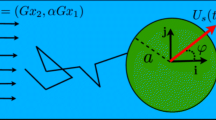Abstract
Purcell’s swimmer was proposed by E. M. Purcell to explain bacterial swimming motions. It has been proved experimentally that a swimmer of this kind is possible under inertial-less and high viscous environment. But we could not investigate all the aspects of this mechanism through experiments due to practical difficulties. The computational fluid dynamics (CFD) provides complementary methods to experimental fluid dynamics. In particular, these methods offer the means of testing theoretical advances for conditions unavailable experimentally. Using such methodology, we have investigated the fluid dynamics of force production associated with the Purcell’s swimmer. By employing dynamic mesh and user-defined functions, we have computed the transient flow around the swimmer for various stroke angles. Our simulations capture the bidirectional swimming property successfully and are in agreement with existing theoretical and experimental results. To our knowledge, this is the first CFD study which shows the fact that swimming direction depends on stroke angle. We also prove that for small flapping frequencies, swimming direction can also be altered by changing frequency-showing breakdown of Stokes law with inertia.
Similar content being viewed by others
References
S. Childress. Mechanics of Swimming and Flying, Cambridge, UK: Cambridge University Press, 1977.
E. M. Purcell. Life at low Reynolds number. American Journal of Physics, vol. 45, no. 1, pp. 3–11, 1977.
R. Gilad, A. Porat, S. Trachtenberg. Motility modes of Spiroplasma melliferum BC3: A helical, wall-less bacterium driven by linear motor. Molecular Microbiology, vol. 47, no. 3, pp. 657–669, 2003.
L. Becker, S. A. Koehler, H. A. Stone. Purcell’s swimmer: Which way does it go? In Proceedings of the 53rd Annual Meeting of the Division of Fluid Dynamics, Washington, USA, 2000.
L. E. Becker, S. A. Koehler, H. A. Stone. On self-propulsion of micro-machines at low Reynolds number: Purcell’s three-link swimmer. Journal of Fluid Mechanics, vol. 490, pp. 15–35, 2003.
A. Naja, R. Golestanian. Simple swimmer at low Reynolds number: Three linked spheres. Physical Review E, vol. 69, no. 6, 062901, 2004.
J. E. Avron, O. Raz. A geometric theory of swimming: Purcell’s swimmer and its symmetrized cousin. New Journal of Physics, vol. 10, 063016, 2008.
M. S. Kumar, P. Philominathan. The physics of flagellar motion of E. coli during chemotaxis. Biophysical Reviews, vol. 2, no. 1, pp. 13–20, 2010.
J. Gray, G. Hancock. The propulsion of sea-urchin spermatozoa. Journal of Experimental Biology, vol. 32, no. 4, pp. 802–814, 1955.
J. Keller, S. Rubinow. Slender-body theory for slow viscous flow. Journal of Fluid Mechanics, vol. 75, no. 4, pp. 705–714, 1976.
M. Bzdega, B. D. Robertson, R. Soller, G. Huber, S. A. Koehler. Motion of a robotic Purcell-type swimmer in a granular medium, to be published.
C. Brian. Bio-inspired Fluid Locomotion, Ph.D. dissertation, Mechanical Engineering, Massachusetts Institute of Technology, USA, 2009.
M. Kim, J. C. Bird, A. J. V. Parys, K. S. Breuer, T. R. Powers. A macroscopic scale model of bacterial flagellar bundling. Proceedings of the National Academy of Sciences of the United States of America, vol. 100, no. 26, pp. 15481–15485, 2003.
ANSYS® Fluent, Flows using sliding and dynamic meshes, Help System, ANSYS, Inc., 2010.
X. F. Ye, B. F. Gao, S. X. Guo, L. Q. Wang. Development of ICPF actuated underwater microrobots. International Journal of Automation and Computing, vol. 3, no. 4, pp. 382–391, 2006.
W. Zhang, S. X. Guo, K. Asaka. A new type of hybrid fishlike microrobot. International Journal of Automation and Computing, vol. 3, no. 4, pp. 358–365, 2006.
Author information
Authors and Affiliations
Corresponding author
Additional information
M. Siva Kumar received his B. Sc. and M. Sc. degrees in physics from Bharathidasan University, India in 1993 and 1995, respectively, and the M.Ed. degree from Annamalai University, India in 1997. He was heading the Department of Physics in Indian School Muscat and now teaching in Oman Dental College. He has published several papers on bacterial motion and submitted his doctoral thesis on very low Reynolds number bacterial swimming motion.
His research interests include flagellar hydrodynamics and computational fluid dynamics.
P. Philominathan graduated from St. Joseph’s College, Tiruchirappalli, Tamilnadu, India and got his post-graduation from the same college and obtained his M. Phil. degree from AVVM Sri Pushpam College, Poondi. He got his Ph. D. degree from Bharathidasan University, Tiruchirappalli, Tamilnadu, India in 2001. Since then, his interest has been in the fields of nonlinear dynamics and on certain novel materials (in both bulk and thin-film form). He is currently the head of the Department of Research and Post Graduate Department of Physics, AVVM Sri Pushpam College (Autonomous), affiliated to Bharathidasan University, Tirchirappalli, Tamilnadu, India.
His research interests include nonlinear systems, potentially significant materials, and automation.
Rights and permissions
About this article
Cite this article
Kumar, M.S., Philominathan, P. Purcell’s swimmer revisited. Int. J. Autom. Comput. 9, 325–330 (2012). https://doi.org/10.1007/s11633-012-0651-3
Received:
Revised:
Published:
Issue Date:
DOI: https://doi.org/10.1007/s11633-012-0651-3




